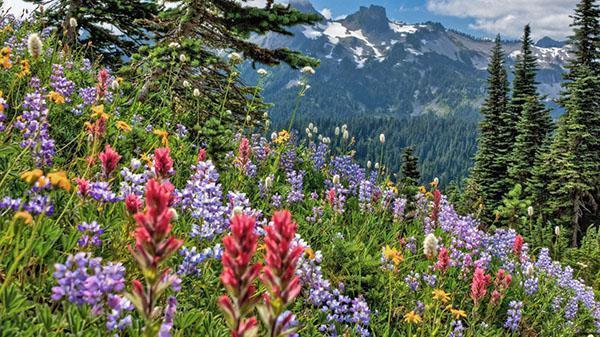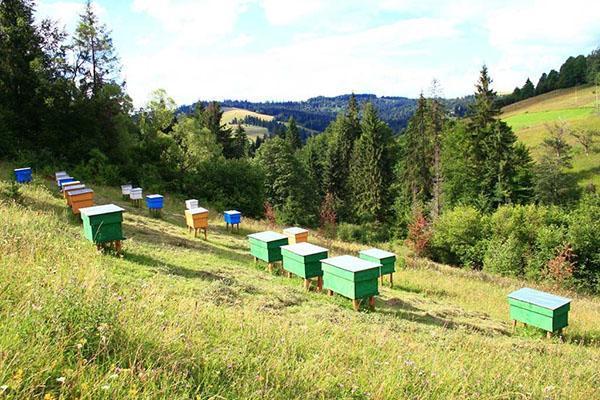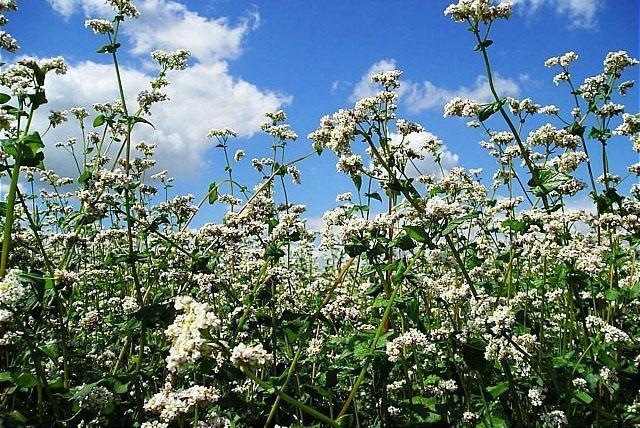Knowing honey herbs for bees, you can consistently receive a good bribe
 Honey grasses for bees are of interest only during the flowering period. Ensuring that the flowering is continuous, from spring to autumn, is the main task for the efficient operation of the apiary. Plants with prolonged flowering, emitting large amounts of nectar and pollen, are referred to as honey plants. The flower conveyor includes cultivated fields with buckwheat and cotton, melliferous grasses in cultivation, flowering trees and shrubs. Additional honey harvest is obtained from naturally sown fireweed fields, dandelion fields and meadows.
Honey grasses for bees are of interest only during the flowering period. Ensuring that the flowering is continuous, from spring to autumn, is the main task for the efficient operation of the apiary. Plants with prolonged flowering, emitting large amounts of nectar and pollen, are referred to as honey plants. The flower conveyor includes cultivated fields with buckwheat and cotton, melliferous grasses in cultivation, flowering trees and shrubs. Additional honey harvest is obtained from naturally sown fireweed fields, dandelion fields and meadows.
Use of natural and cultural resources for honey collection

- the main cultivated melliferous plants - sunflower, buckwheat, cotton, coriander;
- cultivated melliferous herbs for bee supply;
- wild trees and shrubs - linden trees, acacia, maple;
- meadow and forest grasses.
Only by using all the honey herbs for bees can a continuous abundant flow of bribes be achieved.
Therefore, beekeepers use agricultural land to grow the most productive plants. Often during the flowering of fields with legumes and sunflowers, the apiary is set on the side of the road, providing bees with a short path to the plants.
 The beekeeper sows his own areas with one-year or two-year-old honey grasses for bees in order to provide the workers with raw materials in due time. Sowing of grasses of melliferous plants regulated in time ensures periods when there are few flowering plants in the vicinity.
The beekeeper sows his own areas with one-year or two-year-old honey grasses for bees in order to provide the workers with raw materials in due time. Sowing of grasses of melliferous plants regulated in time ensures periods when there are few flowering plants in the vicinity.
If agricultural farms are located nearby, it is necessary to establish contact with an agronomist. Sometimes bees fly far away for a bribe and may find themselves in a foreign field on the day of treatment with chemicals. This should be avoided.
The calendar of the honey conveyor in each area is compiled based on climatic conditions. The most active nectar carriers are selected for cultivation. Of the thousands of flowering plants, two dozen productive honey plants are used, sown specifically for bees.
If the apiary is stationary, the task of the beekeeper within a radius of 2 km is to have their own cultivated fields of peduncles.
The entire area is divided into separate sectors. The plots are planted in sequence, including several types of annual and biennial shrubs. When to plant honey grasses for bees depends on the timing of flowering to create conditions for continuous flow.
Honey conveyor calendar for the Central Russian plain
 Ensuring the continuity of flowering from April to November for a stationary apiary is the main task of the owner. To create conditions for development, 50 families of bees will need to master 50 hectares of near-hazardous lands, plant various flowering trees and shrubs around the perimeter. It will be necessary to improve the flora of meadows and copses. Land work will pay off a hundredfold with good honey collection.
Ensuring the continuity of flowering from April to November for a stationary apiary is the main task of the owner. To create conditions for development, 50 families of bees will need to master 50 hectares of near-hazardous lands, plant various flowering trees and shrubs around the perimeter. It will be necessary to improve the flora of meadows and copses. Land work will pay off a hundredfold with good honey collection.
From early spring to late autumn, bee nectar will be provided by plants:
- In April, the willow blooms, its flowers in bouquets are carried to the church for lighting on Palm Sunday. At the same time, the mother-and-stepmother, the most valuable honey plant, blooms. The first marketable honey is obtained from the willow.
- The gardens bloom in May. Their flowering lasts a month and the more species fruit trees and shrubs in the garden, the aroma of honey is richer. At the same time, ineradicable dandelions are triumphantly blooming. They are easy to breed around the apiary in abundance. A month of honey collection will be provided.
- In June, the bee colony has increased, they need a large base. By this time, the sown fields with honey plants should bloom. Phacelia, white sweet clover and bruise are considered all-weather herbs. However, sweet clover and bruises will grow on uncultivated soil, just make grooves and add more seeds so that the wild grass does not crush at first.
- Sowing of melliferous grasses is repeated at intervals to ensure flowering in September. Another technique to prolong flowering is pruning, mowing the tops. Then the bush branches and blooms again. Bloom late oil radish, mustard and phacelia. Common heather, mordovnik, goldenrod - plants from which you can get extreme bribes before the onset of frost.
 Among experts, the most valuable is meadow and mountain honey. This fact can be explained by the forbs of a meadow glade. If there are meadows around the apiary, it is necessary to re-sow motherwort, fireweed, clover and other aromatic plants in them. Organize the flowering continuity of the meadow.
Among experts, the most valuable is meadow and mountain honey. This fact can be explained by the forbs of a meadow glade. If there are meadows around the apiary, it is necessary to re-sow motherwort, fireweed, clover and other aromatic plants in them. Organize the flowering continuity of the meadow.
Blackroot blooms all summer long, and you can't do without it in the apiary - it scares away mice and a harmful moth.
The results indicate the correct conveyor of honey plants from Siberian grasses in the Priargunsky KHL "Donnik". When to plant honey herbs for bees and how many kilograms per hectare is shown in the table:
| Honey plant | 17-20.04 | 3-6.05 | 3-8.06 | 3-5.07 | 15-18.07 |
| Sweet clover / phacelia | 6/4 | 6/4 | 6/4 | 6/4 | 0/4 |
| Phacelia / bruise | 4/4 | 4/4 | 4/4 | 4/4 | 0/0 |
Melilot and bruise are biennial crops, the sown field will work for 2 years. As a result, the honey yield is 150-200 kg per family. There is no honeydew honey, swarming is under control.
Wild-growing honey herbs for bees in Siberia
Great Siberia! There are fertile regions here, with carrots wintering under the snow in the Novosibirsk region and the scarce endless steppes of the Sayan foothills. Bees live everywhere. The honey collected from thyme and fireweed is not inferior to Western varieties in taste. Honey grasses for Siberian bees are represented by field plants.
 The noxious weed of the field thistle is a rhizome perennial. It fills uncultivated cultivated lands, but is an excellent honey plant, producing 380 kg per hectare of pollen and nectar. Sow thistle blooms in Siberia in spring and autumn, in the middle lane in summer.
The noxious weed of the field thistle is a rhizome perennial. It fills uncultivated cultivated lands, but is an excellent honey plant, producing 380 kg per hectare of pollen and nectar. Sow thistle blooms in Siberia in spring and autumn, in the middle lane in summer.
 Nature does not like emptiness, and next year burns are dragged on by endless fields of fireweed, willow-tea. The end of the sultry Siberian summer in the taiga is always associated with the victorious bloom of useful grass. An excellent honey plant gives up to 500 kg of nectar per hectare. A cream-colored healing product is obtained from this plant.
Nature does not like emptiness, and next year burns are dragged on by endless fields of fireweed, willow-tea. The end of the sultry Siberian summer in the taiga is always associated with the victorious bloom of useful grass. An excellent honey plant gives up to 500 kg of nectar per hectare. A cream-colored healing product is obtained from this plant.
 Yarrow is kind of a minor melliferous plant, but without its aroma and special medicinal properties, meadow honey will lose a lot. Yarrow blooms up to the deepest frosts, unpretentious, grows on hills.
Yarrow is kind of a minor melliferous plant, but without its aroma and special medicinal properties, meadow honey will lose a lot. Yarrow blooms up to the deepest frosts, unpretentious, grows on hills.
 Common bruise is found in the wild in Siberia, in dry steppes. This herb is considered one of the most valuable melliferous plants and is used for sowing cultivated fields. Bruise, self-sown plant. For development, he needs the sun, it blooms until frost. The nectar is not washed off by the rain and does not drain - it is waiting for the collector. From a hectare sown with a bruise, you can collect 850 kg of nectar.
Common bruise is found in the wild in Siberia, in dry steppes. This herb is considered one of the most valuable melliferous plants and is used for sowing cultivated fields. Bruise, self-sown plant. For development, he needs the sun, it blooms until frost. The nectar is not washed off by the rain and does not drain - it is waiting for the collector. From a hectare sown with a bruise, you can collect 850 kg of nectar.
Siberia is rich in plants with strong medicinal properties, and honey from Siberian herbs is considered healing.
Below are the best honey herbs for bees, photos with names and a brief description.
Melilot yellow
 This plant is hard to forget. Mighty bushes, growing flush with man, occupy the leanest soil.The intoxicating scent of blooming sweet clover, the measured hum of bees, remains in the memories of summer for a long time. Sweet clover with nectar always, even in bad weather. Honey harvest up to 600 kg per hectare. The characteristic color of honey - white or amber, is distinguished by aroma, crystallizes over time.
This plant is hard to forget. Mighty bushes, growing flush with man, occupy the leanest soil.The intoxicating scent of blooming sweet clover, the measured hum of bees, remains in the memories of summer for a long time. Sweet clover with nectar always, even in bad weather. Honey harvest up to 600 kg per hectare. The characteristic color of honey - white or amber, is distinguished by aroma, crystallizes over time.
Phacelia
 Phacelia is not only a good source of honey, it is a wonderful green manure that heals and fertilizes the soil. For the beekeeper, more important is the panicle of its successively opening flowers throughout the month. Having sown grass 4 times per season, you can have a blooming field before frost. Still at -90 It secretes nectar from phacelia. The flowers do not close at night and the bees return from this field late. Up to 500 kg of honey can be harvested from a phacelia plantation.
Phacelia is not only a good source of honey, it is a wonderful green manure that heals and fertilizes the soil. For the beekeeper, more important is the panicle of its successively opening flowers throughout the month. Having sown grass 4 times per season, you can have a blooming field before frost. Still at -90 It secretes nectar from phacelia. The flowers do not close at night and the bees return from this field late. Up to 500 kg of honey can be harvested from a phacelia plantation.
There are also valuable heather, linden and other types of honey that you need to know about in order to choose the right product.